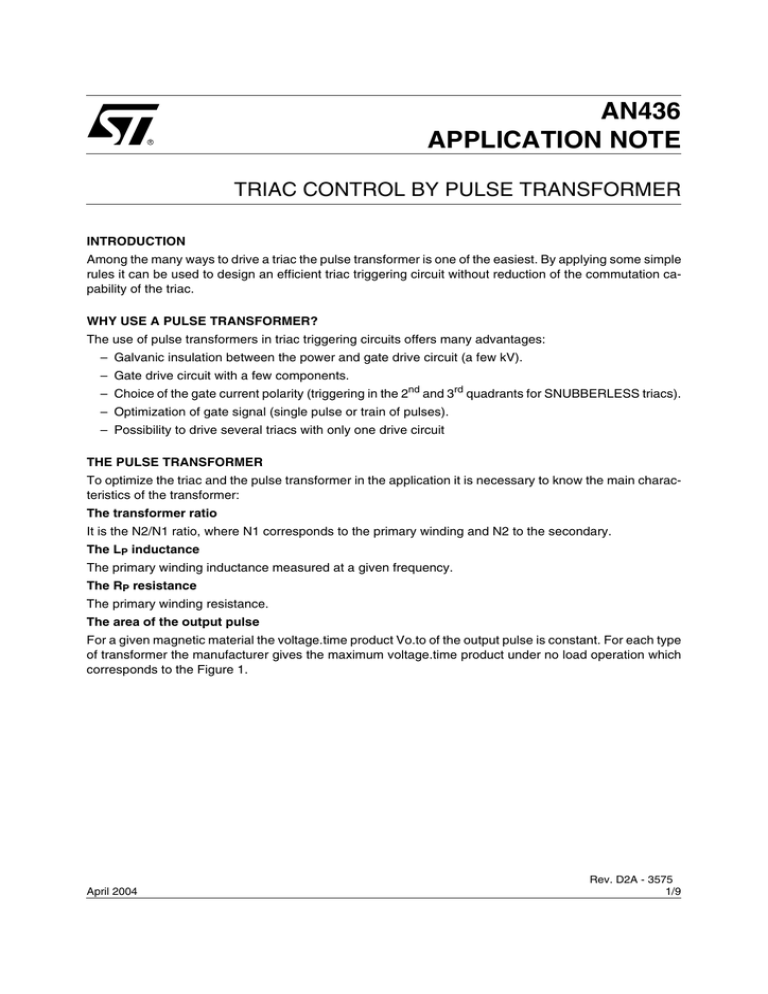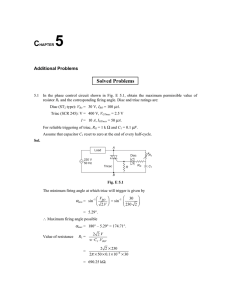
AN436
APPLICATION NOTE
TRIAC CONTROL BY PULSE TRANSFORMER
INTRODUCTION
Among the many ways to drive a triac the pulse transformer is one of the easiest. By applying some simple
rules it can be used to design an efficient triac triggering circuit without reduction of the commutation capability of the triac.
WHY USE A PULSE TRANSFORMER?
The use of pulse transformers in triac triggering circuits offers many advantages:
– Galvanic insulation between the power and gate drive circuit (a few kV).
– Gate drive circuit with a few components.
– Choice of the gate current polarity (triggering in the 2nd and 3rd quadrants for SNUBBERLESS triacs).
– Optimization of gate signal (single pulse or train of pulses).
– Possibility to drive several triacs with only one drive circuit
THE PULSE TRANSFORMER
To optimize the triac and the pulse transformer in the application it is necessary to know the main characteristics of the transformer:
The transformer ratio
It is the N2/N1 ratio, where N1 corresponds to the primary winding and N2 to the secondary.
The LP inductance
The primary winding inductance measured at a given frequency.
The RP resistance
The primary winding resistance.
The area of the output pulse
For a given magnetic material the voltage.time product Vo.to of the output pulse is constant. For each type
of transformer the manufacturer gives the maximum voltage.time product under no load operation which
corresponds to the Figure 1.
April 2004
Rev. D2A - 3575
1/9
AN436 APPLICATION NOTE
Figure 1. Voltage across the secondary winding for a rectangular pulse across the primary
VS
VO
VO
2
tO
t
The rise time tr
This parameter tr defines the rise time of the output pulse as shown in Figure 2.
Figure 2. Specification of the rise time at the output of the transformer
VS
VO
0.7VO
tr
t
Figure 3 shows the diagram of the secondary of the transformer.
Figure 3. Equivalent diagram of the transformer
RP(N2/N1)2
U N2/N1
LP(N2/N1)2
GATE PULSE
Peak value
The transformer ratio and the power supply of the primary winding define the secondary voltage. With the
equivalent diagram and triac gate characteristics it is possible to determine the output current. This has to
2/9
AN436 APPLICATION NOTE
be higher than the specified gate triggering current (IGT). To have an efficient triggering it is suitable to use
a safety coefficient of 2:
IG > 2 IGT
Duration
The Vo.to product defines the maximum pulse duration at the output of the transformer. The anode current
has to be higher than the specified latching current (IL) at the end of the gate pulse.
For drives with a pulse train we can sometimes use very short pulses ( for example tp =10µs with a 15µs
cycle).
For proper triac triggering the gate current rise time is very important in a circuit with very high di/dt (>20
A/µs): case of resistive load.
THE COMMUTATION
The use of a triac with a pulse transformer needs some precautions in order not to decrease the commutation capability.
The commutation
Review: during the conduction a certain quantity of charges is injected into the triac.
During the fall of the current most of them disappear by recombination. If the current decreases too fast
the charges do not have time to recombine and some charge stays in the gate area. This can provoke a
spurious firing.
The parameter which characterizes the commutation is the anode current slope (di/dt)c, that is to say the
slope of current before zero crossing.
The specified value in the data sheet is the critical (di/dt)c. Above this value the triac is liable to fire spuriously. Figure 5 shows the spurious firing due to (di/dt)c.
Case of a triac triggered by a transformer
When the triac is on, a voltage of about 0.6V appears across the gate and cathode. This voltage is either
positive or negative depending on the anode current polarity. A current i can flow through the secondary
winding of the transformer (see Figure 4).
Figure 4. Use of a triac with a pulse transformeur: when the Triac is on a current flows through the
gate
IA
i
VAK
VGK
Due to the inductance of the transformer, at the end of the half wave the current i continues to flow in the
gate and increases the risk of spurious firing at the next cycle (see Figure 5).
3/9
AN436 APPLICATION NOTE
Figure 5. spurious firing of the triac
spurious firing
IANODE
5A/div
0
VAK
50V/div
0
IG
0
50mA/div
The influence of the transformer can be estimated by measuring the critical (di/dt)c of the triac with and
without the transformer.
Example: BTA06-400CW
The specified (di/dt)c of this triac is:
3.5A/ms min at Tj = 125°C
Measurement of a sample without transformer:
(di/dt)c = 6A/ms
Measurement with transformer:
(di/dt)c = 3A/ms → on this sample the commutation capability is divided by 2!
It is necessary to consider this phenomena and to take some safety margin (in some cases the critical (di/
dt)c of the triac + transformer can be lower than the specified (di/dt)c of the triac as shown in the previous
example). This is very important in the case of transient currents higher than the nominal value, as is the
case with the cold filament of incandescent lamp, load dispersion, etc...
One has to take into account the maximum (di/dt)c in the application in all cases, especially in the transient
state where (di/dt)c can be higher than it is in the steady state. The following example shows values for an
incandescent lamp and universal motor.
Table 1. Maximum (di/dt)c in the application
INCANDESCENT LAMP
UNIVERSAL MOTOR
1.35A
3.8A
STEADY STATE (di/dt)c
0.6A/ms
1.7A/ms
TRANSIENT STATE (di/dt)c
2.6A/ms
5A/ms
NOMINAL CURRENT IARMS
4/9
AN436 APPLICATION NOTE
THE SOLUTION
To avoid the reinjected current through the transformer it is necessary to connect a diode in series with
the gate (see Figure 6).
Figure 6. Bearing of the commutation capability
IA
VF
VAK
VGK
The drop voltage VF of the diode avoid the reinjected current. The triac is triggering in the 2nd and 3rd quadrants (see Figure 7).
Figure 7. Correct running with diode
no spurious firing
IANODE
5A/div
0
VAK
50V/div
0
IG
0
50mA/div
5/9
AN436 APPLICATION NOTE
TYPICAL APPLICATION EXAMPLE
Figure 8. Typical application diagram.
+U
LOAD
BZW04-376BT
R
R1
C
D2
SNUBBERLESS
TRIAC
D1
220V
The D2 transil diode protects the triac against overvoltages (see "Protection of triacs and their control circuits" in the "Thyristors and Triacs Application manual").
The RC circuit across R1 allows an increase in the current in the transformer at the beginning of the pulse.
When C is charged the resistance R1 limits the current through the transistor.
The gate current is given by the following formula (without RC).
Figure 9. Equivalent diagram
2
(RP+R1)(N2/N1)
U N2/N1
LP(N2/N1)2
IG
IG
VF
VGK
N2 2
V GK – V F + U --------
N1
( V GK – V F )tp
= ---------------------------------- + ---------------------------------------------------N2 2
N2 2
L P --------
( R P + R1 ) --------
N1
N1
Where: tp is the pulse duration.
Keep in mind that VGK is negative because the triac is triggering in the 2nd and 3rd quadrants.
6/9
AN436 APPLICATION NOTE
In practice the area of the pulse has to be lower than 60 or 70% of the maximum voltage.time product
Vo.to.
The maximum pulse duration in the output is:
0.7Vo.to
t P = -----------------------V F – V GK
These two formulæ allow us to define the pulse transformer according to the triac sensitivity.
Example: Numerical application with a transformer having the following characteristics:
N2/N1 = 1
RP = 0.6Ω
LP = 2.5mH
Vo.to = 250Vµs
Triac: BTA08-700CW
IGT = 35mA; VGK = –2V at IG = 2IGT (quadants II and III)
diode: VF = 0.7V
Power supply:
U = 12V; R1 = 100Ω; tp max = 65µs; IG = 70mA; t = 21µs
We have measured:
IG = 85 mA at t = 21µs
CONCLUSION
The pulse transformer provides an excellent method to trigger a triac when galvanic insulation is required.
This system is appropriate to microprocessor systems.
Nevertheless it needs some precautions to avoid a decrease of the triac commutation behavior.
This precaution is achieved by adding a diode in series with the gate.
7/9
AN436 APPLICATION NOTE
REVISION HISTORY
Table 2. Revision History
8/9
Date
Revision
Description of Changes
May-1992
1
First Issue
23-Apr-2004
2
Stylesheet update. No content change.
AN436 APPLICATION NOTE
Information furnished is believed to be accurate and reliable. However, STMicroelectronics assumes no responsibility for the consequences
of use of such information nor for any infringement of patents or other rights of third parties which may result from its use. No license is granted
by implication or otherwise under any patent or patent rights of STMicroelectronics. Specifications mentioned in this publication are subject
to change without notice. This publication supersedes and replaces all information previously supplied. STMicroelectronics products are not
authorized for use as critical components in life support devices or systems without express written approval of STMicroelectronics.
The ST logo is a registered trademark of STMicroelectronics.
All other names are the property of their respective owners
© 2004 STMicroelectronics - All rights reserved
STMicroelectronics GROUP OF COMPANIES
Australia - Belgium - Brazil - Canada - China - Czech Republic - Finland - France - Germany - Hong Kong - India - Israel - Italy - Japan Malaysia - Malta - Morocco - Singapore - Spain - Sweden - Switzerland - United Kingdom - United States
www.st.com
9/9



